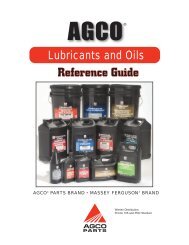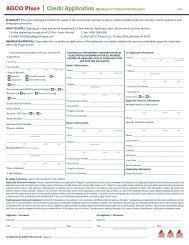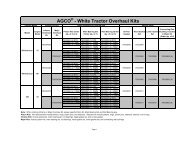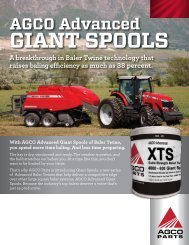Controllers - AGCO Parts
Controllers - AGCO Parts
Controllers - AGCO Parts
Create successful ePaper yourself
Turn your PDF publications into a flip-book with our unique Google optimized e-Paper software.
A GUIDE TO CLEANING YOUR SPRAYERS<br />
Step-by-Step Instructions for Cleaning Equipment After Application<br />
Technical Pages<br />
1 Flush tank, hoses, boom and nozzles with clean<br />
water.<br />
2<br />
Prepare a cleaning solution using a Novartis-approved<br />
commercial tank cleaner, such as <strong>AGCO</strong> ® Dry Tank<br />
Cleaner. Read the cleanser label for the correct rate.<br />
Read the following sections for instructions on proper<br />
tank cleaning procedures. Do not use chlorine-based<br />
cleaners such as Clorox ® .<br />
3<br />
Use a pressure washer to clean the inside of the spray<br />
tank with this solution. Take care to wash all parts of<br />
the tank, including the inside top surface.<br />
4<br />
Completely fill the sprayer with the cleaning solution to<br />
ensure contact of the cleaning solution with all internal<br />
surfaces of the tank and plumbing. Start agitation in<br />
the sprayer and thoroughly recirculate the cleaning<br />
solution for at least 15 minutes. All visible deposits<br />
must be removed from the spraying system.<br />
5<br />
Flush hoses, spray lines and nozzles for at least one<br />
minute with cleaning solution.<br />
Tank-Rinsing Nozzles<br />
MULTIPLE<br />
SPRAY<br />
ORIFICES<br />
MULTIPLE<br />
SPRAY<br />
ORIFICES<br />
6<br />
7<br />
8<br />
9<br />
Note:<br />
Dispose of rinsate from steps 1–5 in an appropriate<br />
manner. Spray the cleaning solution on untreated<br />
corn or return to a rinsate tank for later use as<br />
makeup water for spraying corn.<br />
Repeat steps 2–5 again.<br />
Remove nozzles, screens and strainers and clean<br />
separately in the cleaning solution after completing<br />
the above procedures.<br />
Rinse the complete spraying system with clean<br />
water.<br />
1) If the tank is equipped with the proper number of<br />
correctly-mounted 360° tank-washing nozzles<br />
which are attached to a dedicated rinsing system,<br />
less than a full tank cleaning solution may be used.<br />
Use sufficient cleaning solution to thoroughly rinse<br />
all surfaces. Start the sprayer agitation and recirculate<br />
solution for at least 15 minutes. Flush the spray<br />
boom with the cleaning solution. Repeat the rinsing<br />
procedure 1–2 times.<br />
2) If the sprayer contains obvious residue buildup or<br />
when switching to a crop which is especially sensitive<br />
to the last herbicide used, follow step 4 above,<br />
even if a tank-rinsing system is in place.<br />
u Nozzles should rotate 360° so that all inside surfaces of<br />
the tank can be wetted by the spray. It is important that<br />
the inside top of the tank and all of the corners are in direct<br />
contact with rinsing spray.<br />
u The tank-rinsing system will include a separate tank<br />
which is used for holding nothing but cleaning solution.<br />
u Install at least two rinsing nozzles in each tank. One<br />
positioned on either side of the tank lid.<br />
u In sprayers with baffled tanks, use one nozzle per baffled<br />
section.<br />
Several companies manufacture special nozzles for rinsing<br />
spray tanks. These should be permanently mounted in<br />
the top of the spray tank. A properly-designed tank-rinsing<br />
system will have these characteristics:<br />
u Following rinsing system manufacturer’s guidelines for<br />
correct installation, operation, and maintenance of the<br />
equipment.<br />
u Routinely rinse the sprayer thoroughly with clean water or<br />
cleaning solution and drain all lines. Use of rinsing<br />
nozzles is no substitute for practicing complete cleaning<br />
practices.<br />
258<br />
Please Note: For a complete <strong>AGCO</strong> part number; please add AG to the front of the six digit number.

















